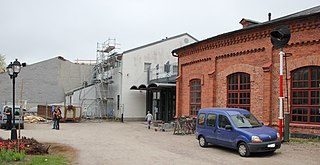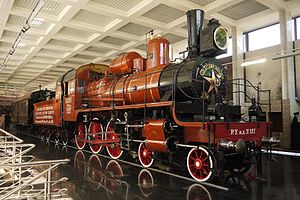Under the Whyte notation for the classification of steam locomotives, 2-10-0 represents the wheel arrangement of two leading wheels on one axle, ten powered and coupled driving wheels on five axles, and no trailing wheels. This arrangement was often named Decapod, especially in the United States, although this name was sometimes applied to locomotives of 0-10-0 "Ten-Coupled" arrangement, particularly in the United Kingdom. Notable German locomotives of this type include the war locomotives of Class 52.

Under the Whyte notation for the classification of steam locomotives by wheel arrangement, 4-6-0 represents the configuration of four leading wheels on two axles in a leading bogie and six powered and coupled driving wheels on three axles with the absence of trailing wheels. In the mid 19th century, this wheel arrangement became the second most popular configuration for new steam locomotives in the United States of America, where this type is commonly referred to as a Ten-wheeler. As a locomotive pulling trains of lightweight all wood passenger cars in the 1890-1920s, it was exceptionally stable at near 100 mph speeds on the New York Central's New York to Chicago Water Level Route and on the Reading Railroad's Camden to Atlantic City, NJ, line. As passenger equipment grew heavier with all steel construction, heavier locomotives replaced the Ten Wheeler.

The Finnish Railway Museum is located in Hyvinkää, Finland. It was founded in 1898 and located in Helsinki. The museum was moved to Hyvinkää in 1974.

Richmond Locomotive Works was a steam locomotive manufacturing firm located in Richmond, Virginia.

St Petersburg–Finlyandsky, is a railway station in St. Petersburg, Russia, handling transport to westerly destinations including Helsinki and Vyborg.

The Deutsche Reichsbahn's Class 52 is a German steam locomotive built in large numbers during the Second World War. It was the most produced type of the so-called Kriegslokomotiven or Kriegsloks. The Class 52 was a wartime development of the pre-war DRG Class 50, using fewer parts and less expensive materials to speed production. They were designed by Richard Wagner who was Chief Engineer of the Central Design Office at the Locomotive Standards Bureau of the DRG. About a dozen classes of locomotive were referred to as Kriegslokomotiven; however, the three main classes were the Class 52, 50 and 42. They were numbered 52 1-52 7794

Varshavsky station, or Warsaw station, is a former passenger railway station in Saint Petersburg, Russia, also formerly home of the Central Museum of Railway Transport, Russian Federation.

Rizhsky station is one of the nine main railway stations in Moscow, Russia. It was built in 1901. As well as being an active station it also houses the Moscow Railway Museum. The station is operated by the Moscow Railway.

The Soviet locomotive class IS was a Soviet passenger steam locomotive type named after Joseph Stalin. The contract design was prepared in 1929 at V.V. Kuybyshev Locomotive Factory in Kolomna. The IS series locomotives were manufactured between 1932 and 1942.

The Russian steam locomotive class O was an early type of Russian steam locomotives. Between 1890 and 1928, 9129 locomotives were built; hence it was the second most numerous class of locomotive in Russia, after E class, which was a unique number even on the international level.

The Soviet locomotive class FD was a Soviet main freight steam locomotive type named after Felix Dzerzhinsky. Between 1932 and 1942, 3213 FD series locomotives were built.

The Finnish VR Class Tk3 was a 2-8-0 light freight locomotive. It was the most numerous steam locomotive class in Finland with 161 built. 100 locomotives were constructed between 1927 and 1930, with a further 61 ordered and constructed 1943–53. They were numbered 800–899, 1100–1118, and 1129–1170.

The Russian locomotive class Ye, and subclasses Yea, Yek, Yel, Yef, Yem, Yemv and Yes were a series of 2-10-0 locomotives built by American builders for the Russian railways in World War I and again in World War II. They were lightweight engines with relatively low axle loadings.

The Museum of the Moscow Railway is situated next to Paveletsky Rail Terminal in Moscow. The museum reopened to private visitors in 2011 and it reopened to the general public in January 2012.

The Russian locomotive class U was a Russian express passenger steam locomotive type. The class U was a 4-6-0 four-cylinder compound locomotive which used de Glehn compound system.

The Russian steam locomotive class Izhitsa (Ѵ) was a steam locomotive produced in Russia and the Soviet Union between 1908 and 1918, and between 1927 and 1931. The Russian letter Ѵ can be transliterated as Hy. On Russian and Soviet railways, these were the most powerful steam locomotives of type 0-8-0. They were designed by E. E. Noltein and had a 16-ton axle load.

The Kolomna Locomotive Works is a major producer of railroad locomotives in Russia. The plant started production in 1869 with a freight steam locomotive, one of the first in Russia. In the Czarist period before the Russian Revolution, Kolomna was one of a very few producers in Russia. During this period 139 types of steam locomotives were designed. The company is now (2015) a part of Transmashholding.

The Soviet locomotive class LV was a Soviet main freight steam locomotive type. Between 1952 and 1956, 522 locomotives were built.

The Soviet locomotive class P36 was a Soviet mainline passenger steam locomotive type. Between 1950 and 1956, 251 locomotives were built. The locomotives were nicknamed "Generals" because of the red stripe down the side. The P36 had the same power as a class IS locomotive but the axle loading of 18 tons allowed its use on the vast majority of Russian railway lines, replacing class Su 2-6-2s and significantly increasing the weight of passenger trains. The P36 was the last type of mainline steam locomotive built in Russia and the last one built, P36-0251, was the last steam locomotive produced by Kolomna Works. Though sometimes described as the "Victory" type locomotive, that moniker actually belongs to the class L 2-10-0 built between 1945 and 1947.

The Russian Railway Museum is situated next to Baltiysky railway station in Saint Petersburg. The museum was established in 1978, its current site and exhibition opened to public on 1 November 2017. The museum utilizes the nineteenth century locomotive shed of the Peterhof Railway built in 1857–1858, however a large second exhibition building and open exhibition areas have been added.




























